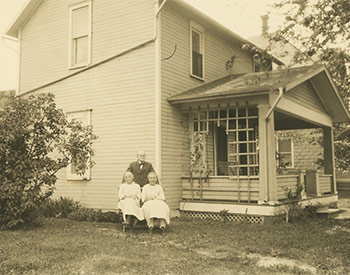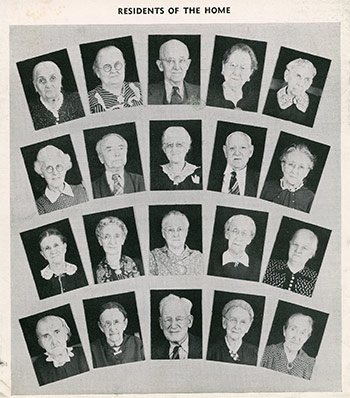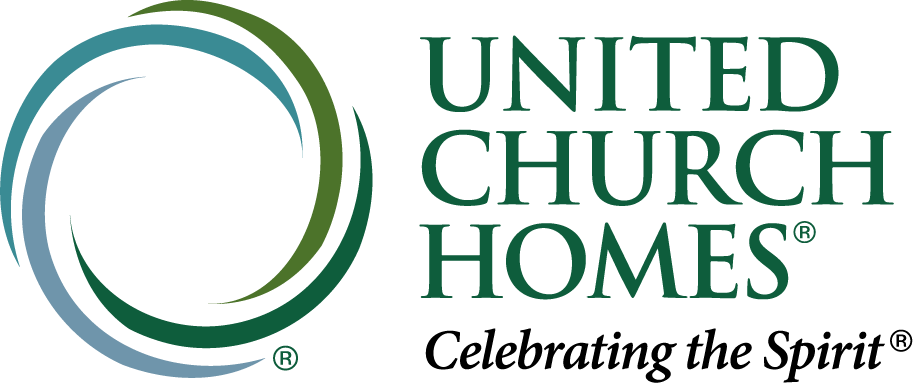As we piece together the reasons why the German Reformed Churches began this journey, we have to consider their common faith, language, heritage, and experience of aging at the beginning of the 20th century. It was the common mission with the church that made the idea possible.
Common Faith.
From 1563, in the Reformed church, irrespective of which side of the Atlantic Ocean one was raised, one studied the Heidelberg catechism, the religious instruction prior to official membership into the church. There were 129 questions and answers arranged in three parts: “The Law of God,” “The Grace of God in Jesus Christ,” and “New Life in the Holy Spirit.” Knowledge of the questions, memorization of the answers, familiarity with the full document, and awareness of the scripture passages were part of the study leading to common tenets of faith.
In the last section, concerning life in the Spirit, the showing of good works is the way to respond to God’s goodness out of gratitude for all that God through Christ gives. The answer to question 91 states that actions are to be “done of true faith” and for “God’s glory.” Belief in itself was not enough, but faith in Christ was to bear fruits, to do good works.
In A Brief History: 1917-1940 of the Synod of the Northwest, it is explained that: “The laudable purpose in (establishing the Home for the Aged) was to provide an ideal Christian Home in answer to the prayer of the aged members of our church, “Forsake me not in my old age,” as well as in loving response to the commandment: “Thou shalt honor thy father and thy mother”.
This was a faith-based ministry responding to real needs in their own faith communities.
Common Language and Heritage.
Immigrants from the Reformed areas of Germany settled in Pennsylvania and the central eastern states during the 1700’s and early 1800’s. As the wave of immigrants from Germany and Switzerland increased through the 19th century, the church spread its mission past the Allegheny Mountains and established congregations in what would become Ohio, Indiana, and beyond. The heritage of people coming from the same homeland, together with their common language and faith, would draw them to settle in common communities.
By 1824 there were enough German Reformed congregations in the state to form the Synod of Ohio. The Synod provided the opportunity for churches to engage in projects, missions, and provide support, which individual congregations could not do alone. By 1850 the Synod of Ohio established a seminary to train ministers and teachers in Tiffin, Ohio, at Heidelberg College. Another seminary was established in 1863, and by 1900, a publishing house and Fairview Hospital were all providing good works in Cleveland. The Reformed Church was finding ways to meet the needs.
As early as the mid-1800’s, the Reformed Church set up a fund to help support ministers and particularly their widows. Homes for the aged and orphans were supported by various synods in Pennsylvania and by the Evangelical Germans centered in St. Louis. The members of the Ohio churches were aware of the work of these ministries in other parts of the growing country.
Common Experience.
Meanwhile, the industrialization of the country was underway. Young people left the family farms and headed to the city to work, leaving aging parents behind. There were no social nets to help support the oldest members of society and few had resources to allow them much leisure in their advancing years. For those older immigrants, their preferred language was German, necessitating the need for care in their advancing years to be spoken in two languages.

Perhaps these factors helped to spark this idea that was shared at the Toledo Classis meeting on June 23, 1916, reported in an article in the Toledo Blade. In addition to the members of the Reformed Churches finding out about the work of their church, a brother and sister, Matthew and Jane Smith, read the article in nearby Holland, Ohio, where they lived on their 165-acre family farm. The siblings decided that this idea of a Home for the Aged was a good one, and although they were not members of the Reformed Church, they began negotiations with church leaders to leave all their possessions and property for this cause. In 1917 this good news became complicated as both Matthew and Jane died, and distant relatives contested the will.
“Brother, Sister, take a hold with a cheerful heart; be one of them who build this home in the name of God.”
– Rev. B. Ruf
Simultaneous to working on a resolution to this litigation, the newly formed Board of Trustees knew that they needed additional support for the ongoing ministry. As stated in the first Report of the Board of Trustees for 1916-1918, they did not want something “…which has been begun with so much labor, prayer and patience…to be neglected and be made to suffer a possible decline.” Their vision was of a long lasting ministry.
Acting as the financial agent, board member Rev. B. Ruf, a Swiss immigrant, began the fund-raising efforts. Rev. Ruf had received his education for ministry in Cleveland and Tiffin. He served two Reformed congregations in Indiana before becoming the superintendent of Fort Wayne Orphans’ Home, known today as Crossroads. For three years, 1916-1918, he spread the word and shared the vision, imploring the members of the church, “Brother, Sister, take a hold with a cheerful heart; be one of them who build this home in the name of God.” In 1918, Rev. and Mrs. Ruf, now the superintendent and matron, moved into a temporary Toledo home on Collingwood Avenue. Mr. and Mrs. Beuhrer, along with three other widows, were the first residents.
Common Mission.
In 1920, the residents and staff of the Toledo home moved to the permanent home in Upper Sandusky. To apply to “find a city of refuge and rest between the walls of the institution,” a portion of the paperwork included the recommendation of the applicant’s local Reformed minister. In addition to reviewing the application, the church had to agree that they would not remove the member from their own membership rolls even though the individual would no longer be living close enough to attend worship or commune regularly, thus breaking the local congregation’s membership “rules.” The effect was to help tie the congregation to the support and relationship with their member and with the church’s mission in the home.
Changes in the larger church were a challenge to the ongoing support of the institution. When confronted with the reality that the Synod was engaged in an effort to raise funds to the exclusion of the Home for the Aged, an urgent, direct appeal was sent to the churches:
“Service is simply the objective manifestation of love. The only way one can prove their [sic] love for others [sic] is through service…No man or woman knows what time shall evolve from the mists of the future. No one can say today what tomorrow shall bring forth, much less what will occur next year. It is possible, however, to render such service that upon the sure foundation of your good example future generations may find an inspiration and a basis for a Christian Institution.”

As late as 1933, The Fair Haven in Upper Sandusky was the only Reformed Church home for the aged west of Pennsylvania. Their new location, just outside the town’s limits, was close enough to enjoy the conveniences of the “city” while in the quiet countryside. Two railroad lines and main highways made it possible for people to visit. In the Reformed Church Year Book in 1930, it was shared that “Those who are making their home here have many kind words for the institution and visitors are impressed with the completeness of our buildings, the comfort and conveniences afforded the residents, and those that have to manage the work and perform the menial duties required of such a place.”
In the earliest times, this shows the cognizant care for residents as well as the work conditions for staff.
Now, a century later, and in the years since the founding of the Home for the Aged, the ministry and mission continue to be nurtured by the roots of faith and understanding of what it means to do good work. Acknowledging that the Spirit inspires those good works, we continue to see the transformational results in our communities today, and we celebrate that this Spirit is alive and well and leading us to make the reality possible.
“Here indeed, is a practical demonstration of the true Christian spirit, expressed by people who are not content to say it should be done, but who by generous gifts make it possible to be done.”
